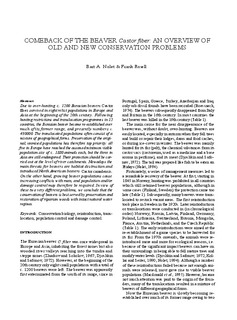Comeback of the beaver Castor fiber : an overview of old and new conservation problems
Journal article, Peer reviewed
Permanent lenke
http://hdl.handle.net/11250/2438001Utgivelsesdato
1998Metadata
Vis full innførselSamlinger
Originalversjon
Biological conservation 83 (1998), No. 2, p. 165-173 http://dx.doi.org/10.1016/S0006-3207(97)00066-9Sammendrag
Due to over-hunting c. 1200 Eurasian previous termbeaversnext term Castor fiber survived in eight relict populations in Europe and Asia at the beginning of the 20th century. Following hunting restrictions and translocation programmes in 15 countries, the Eurasian previous termbeavernext term became re-established over much of its former range, and presently numbers c. 430 000. The translocated populations often consist of a mixture of geographical forms. Preservation of the original, unmixed populations has therefore top priority: all five in Europe have reached the assumed minimum viable population size of c. 1880 animals each, but the three in Asia are still endangered. Their protection should be carried out at the level of river catchments. Nowadays the main threats for previous termbeaversnext term are habitat destruction and introduced North American previous termbeaversnext term Castor canadensis. On the other hand, growing previous termbeavernext term populations cause increasing conflicts with man, and population and/or damage control may therefore be required. In view of these two very different problems, we conclude that the conservation of previous termbeaversnext term is best served by preservation and restoration of riparian woods with intact natural water regimes.
